Mapping Ecological Security Patterns Based on Ecosystem Service Valuation in the Qinling-Daba Mountain Area, China: A Multi-Scenario Study for Development and Conservation Tradeoffs
Abstract
1. Introduction
2. Materials and Methods
2.1. Study Area
2.2. Data Sources
2.3. Methodology
2.3.1. Scenario Designation
2.3.2. Methods for Ecosystem Service Valuation
2.3.3. Method for Ecological Corridor Construction: Minimum Cumulative Resistance Model
2.3.4. Method for Important Ecological Corridor and Strategic Point Identification
3. Results
3.1. Ecosystem Service Values
3.2. Distribution of Ecological Sources in Different Scenarios
3.3. Distribution of Ecological Corridors in Different Scenarios
3.4. Important Ecological Corridors and Strategic Points
4. Discussion
4.1. Tradeoffs between Conservation and Development in Ecological Security Pattern
4.2. Strategic Points Identification and Management
4.3. Limitations of This Study and Future Directions
5. Conclusions
- Governments should make policies and take action to encourage farmers to adopt sustainable agricultural practices. For example, they could provide financial subsidies to offset the initial costs, offer tax incentives to reward environmentally friendly farming methods, and organize technical training programs to educate farmers on sustainable techniques. These measures would encourage more farmers to transition to eco-friendly practices, ultimately benefiting both the environment and agricultural productivity.
- Establish a robust implementation mechanism for managing ecological corridors. Detailed planning for ecological corridors should be developed and endorsed by local governments and relevant departments. A cross-departmental coordination mechanism is crucial; departments responsible for environmental protection, transportation planning and management, and agricultural development and management should be involved in the decision-making process for ESP planning and construction.
Author Contributions
Funding
Data Availability Statement
Conflicts of Interest
Appendix A

Appendix B. The Equivalent Coefficient Table for This Study
| Ecosystems | Provisioning Services | Regulating Services | Supporting Services | Cultural Services | |||||||
| Category | Subcategory | Food Production | Raw Material Production | Gas Regulation | Climate Regulation | Decontaminate Environment | Hydrological Regulation | Soil Maintenance | Maintaining Nutrient Cycling | Biodiversity Protection | Aesthetic Landscape |
| farmland | dry land | 0.85 | 0.40 | 0.67 | 0.36 | 0.10 | 0.27 | 1.03 | 0.12 | 0.13 | 0.06 |
| paddy field | 1.36 | 0.09 | 1.11 | 0.57 | 0.17 | 2.72 | 0.01 | 0.19 | 0.21 | 0.09 | |
| forest | coniferous forest | 0.22 | 0.52 | 1.70 | 5.07 | 1.49 | 3.34 | 2.06 | 0.16 | 1.88 | 0.82 |
| broadleaved forest | 0.29 | 0.66 | 2.17 | 6.50 | 1.93 | 4.74 | 2.65 | 0.20 | 2.41 | 1.06 | |
| bush | 0.19 | 0.43 | 1.41 | 4.23 | 1.28 | 3.35 | 1.72 | 0.13 | 1.57 | 0.69 | |
| grassland | prairie | 0.10 | 0.14 | 0.51 | 1.34 | 0.44 | 0.98 | 0.62 | 0.05 | 0.56 | 0.25 |
| shrubs | 0.38 | 0.56 | 1.97 | 5.21 | 1.72 | 3.82 | 2.40 | 0.18 | 2.18 | 0.96 | |
| wetland | wetland | 0.51 | 0.50 | 1.90 | 3.60 | 3.60 | 24.23 | 2.31 | 0.18 | 7.87 | 4.73 |
| bare land | bare land | 0.00 | 0.00 | 0.02 | 0.00 | 0.10 | 0.03 | 0.02 | 0.00 | 0.02 | 0.01 |
| water area | waterbody | 0.80 | 0.23 | 0.77 | 2.29 | 5.55 | 102.24 | 0.93 | 0.07 | 2.55 | 1.89 |
| glacier and snow | 0.00 | 0.00 | 0.18 | 0.54 | 0.16 | 7.13 | 0.00 | 0.00 | 0.01 | 0.09 | |
| construction area | construction area | 0.00 | 0.00 | 0.00 | 0.00 | 0.00 | 0.00 | 0.00 | 0.00 | 0.00 | 0.00 |
Appendix C. Specific Distribution of Intersection Barriers
| Province/City | Scenario B1 | Scenario B2 | Scenario C1 | Scenario C2 | |
| Gansu Province | Dingxi City | Dacaotan Township | |||
| Longnan City | Awu Township, Jugan Township, Changdao Township, Yanguan Township, Paosha Township | ||||
| Yuhuang Township | Yuhuang Township, Zhongmiao Township | Linjiangpu Township, Jialing Township, Chengguan Township (Hui County), Yuhuang Township | Linjiangpu Township, Chengguan Township (Hui County), Jialing Township, Zhongmiao Township | ||
| Henan Province | Nanyang City | Xiping Township, Chongyang Township, Xihuang Township | |||
| Shangji Township, Danshui Township, Nanhedian Township, Cuizhuang Township | Nanhedian Township, Cuizhuang Township, Danshui Township, Shangji Township, | Huiche Township, Shangji Township | |||
| Sanmenxia City | Shuanghuaishu Township | ||||
| Dongming Township, Fanli Township, Hengjian Township | Dongming Township, Fanli Township | ||||
| Luoyang City | Checun Township | ||||
| Tantou Township, Miaozi Township | Tantou Township | ||||
| Hubei Province | Shiyan City | Chengguan Township (Utopia County), Qingqu Township of Wudang Mountain Special Zone | |||
| Shuiping Township, Shuangtai Township, Wenfeng Township, Hualongyan Township, Guanshan Township, Baisangguan Township, Shangjin Township, Huanglong Township, Bolin Township | Guanshan Township, Yaohuai Township of Wudang Mountain Special Zone, Shangjin Township, Baisangguan Township, Huanglong Township, Bolin Township, Shuangtai Township, Wenfeng Township, Shuiping Township | Bolin Township, Wenfeng Township, Shuiping Township | Tuguanya Township, Qingfeng Township, Yinjifu Township, Xiangkou Township, Baoxia Township, Huanglong Township, Yishui Township, Shuiping Township | ||
| Xiangyang City | Xiaohe Township | ||||
| Shaanxi Province | Ankang City | Xianhe Township, Chengguan Township (Ziyang County), Chengguan Township (Pingli County), Lvhe Township, Zongxi Township | |||
| Hongshan Township, Hengkou Township, Jihe Township, Meizi Township, Huangguan Township, Yunwushan Township, Tongmu Township, Shenhe Township | Hengkou Township, Hongshan Township, Jihe Township, Meizi Township, Huangguan Township, Simudi Township, Yunwushan Township, Tongmu Township, Shenhe Township | Tanba Township, Yanba Township, Tongchewan Township, Yunwushan Township, Tongmu Township, Ganxi Township | Goupa Township, Jihe Township, Hengkou Township, Pingliang Township, Zuolong Township, Tongchewan Township | ||
| Shaanxi Province | Baoji City | Pingkan Township, Fengzhou Township | |||
| Hanzhong City | Xingzhou Street Office, Jinshui Township | ||||
| Wuguanyi Township, Matiwan Township, Lesuhe Township, Chadian Township, Xinjiezi Township, Yuandun Township, Xinpu Township, Liangshan Township, Dahekan Township, Tea Township, Moziqiao Township, Jinshui Township, Longting Township, Yangjiahe Township | Yuanjiazhuang Street Office, Wuguanyi Township, Matiwan Township, Lesuhe Township, Xinjiezi Township, Xinpu Township, Qishuba Township, Dahekan Township, Liangshan Township, Guangping Township, Tea Township, Moziqiao Township, Qi’s Street Office, Yangjiahe Township | Yuanjiazhuang Street Office, Xuwang Township, Baiquesi Township, Chadian Township, Yuandun Township, Fuchuan Township, Shengshui Township, Xiaonanhai Township, Hanyuan Street Office, Daijiba Township, Huishuguan Town | Yuanjiazhuang Street Office, Yuhuangmiao Township, Lesuhe Township, Chadian Township, Yuandun Township, Qishuba Township, Hongmiao Township, Yankou Township | ||
| Shangluo City | Zhulinguan Township, Gaobadian Township, Yingpan Township, Huilong Township | ||||
| Longjuzhai Street Office, Sehepu Township, Jinshixia Township, Guofenglou Township, Qingyouhe Township, Chengguan Street Office, Qianyou Street Office, Xiaoling Township, Xingping Township | Longjuzhai Street Office, Guofenglou Township, Qingyouhe Township, Chengguan Street Office, Qianyou Street Office, Xiaoling Township, Xingping Township | Guofenglou Township | Dajing Township, Yicun Township, Xingping Township | ||
| Xi’an City | Shijing Township, Wangchuan Township | ||||
| Sichuan Province | Aba Prefecture | Tumen Township | |||
| Bazhong City | Dongyu Township, Lianghekou Township | ||||
| Guanba Township, Xinchang Township | Guanba Township, Xinchang Township | Guanba Township | |||
| Dazhou City | Hekou Township | Hekou Township | Lishu Township | ||
| Deyang City | Banqiao Township | Banqiao Township | Banqiao Township | ||
| Guangyuan City | Shahe Township, Sanguo Township | ||||
| Gongnong Township, Yaodu Township, Wali Township, Guanyindian Township | Douzhuan Township, Datan Township, Gongnong Township, Daba Township, Muyu Township, Yaodu Township | Gongnong Township, Wali Township, Guanyindian Township, Yaodu Township | Xuanhe Township | ||
| Mianyang City | Longan Township, Gaocun Township | Longan Township | Longan Township | Longan Township | |
| Chongqing | Chongqing | Tucheng Township | Tucheng Township, Jiangkou Township | Jiangkou Township | Tucheng Township |
| Major highways | Lanzhou-Haikou Highway, Wuhan-Jiujiang Highway, Shiyan–Tianshui Highway, Huhhot–Beihai Highway, Shanghai–Xi’an Highway, Zhengzhou-Yaoshan Highway, Macheng–Ankang Highway, Fuzhou–Yinchuan Highway, Ankang-Langao Highway, Beijing–Kunming Highway, Ankang–Laifeng Highway, Ningshan-Shiquan Highway, Yinchuan–Kunming Highway, Highway Tunnel of Qinling Zhongnan Mountain, Wudu-Guanzigou Highway, Guangyuan-Pingwu Highway, Pingliang-Mianyang Highway | ||||
| Mianchi-Xichuan Highway, Erenhot–Guangzhou Highway, Yunxi-Wuxi Highway, Baoji-Hanzhong Highway, Zuoshui-Shanyang Highway | Mianchi-Xichuan Highway, Erenhot–Guangzhou Highway, Yunxi-Wuxi Highway, Baoji-Hanzhong Highway, Xixiang-Zhenba Highway, Zuoshui-Shanyang Highway, | Liandang-Huixian Highway, Meixian-Fengxiang Highway | Mianchi-Xichuan Highway, Zuoshui-Shanyang Highway, Liandang-Huixian Highway, Meixian-Fengxiang Highway | ||
| Major railways | Xiangyang-Chongqing Railway, Baoji-Chengdu Railway, Xi’an-Chengdu High-Speed Railway | ||||
| Haolebaoji-Ji’an Raiway, Yangpingguan-Ankang Railway, Nanjing-Xi’an Railway | Haolebaoji-Ji’an Railway, Yangpingguan-Ankang Railway, Lanzhou-Chongqing Railway, Nanjing-Xi’an Railway, Xi’an-Ankang Railway | Lanzhou-Chongqing Railway, Yangpingguan-Ankang Railway, Xi’an-Ankang Railway | |||
Appendix D. Specific Distribution of Township Barriers
| Province/City | Scenario B1 | Scenario B2 | Scenario C1 | Scenario C2 | |
| Gansu Province | Dingxi City | Lujing Township, Shendu Township | |||
| Gannan Prefecture | Changchuan Township, Dianzi Township, Shimen Township | ||||
| Longnan City | Xiaochuan Township, Chenyuan Township, Lianghekou Township, Shawan Township, Liulin Township, Nianba Township, Lianghe Township, Zhongba Township, Qishan Township, Shiqiao Township, Jugan Township, Sanhe Township, Shibao Township, Changdao Township | ||||
| Paosha Township, Wangba Township, Yongxing Township, Yanguan Township, Huangping Township | Wangba Township, Huangping Township | Paosha Township, Nanyang Township, Ginkgo Tree Township, Yanguan Township, Pipa Township | Nanyang Township, Ginkgo Township, Yanguan Township, Pipa Township, | ||
| Tianshui City | Yan’an Township, Tange Township | ||||
| Henan Province | Luoyang City | Luanchuan Township, Shimiao Township | |||
| Tantou Township, Guxian Township, Old County Township | Tantou Township, Guxian Township, Old County Township | ||||
| Nanyang City | Chongyang Township, Shuanglong Township, Sangping Township, Wuliqiao Township, Jingziguan Township | ||||
| Nanhedian Township, Taishanmiao Township, Liushan Township, Chengjiao Township, Sikushu Township, Huangludian Township, Shimen Township, Chimei Township, Mashankou Township, Yangcheng Township, Danshui Township, Shangji Township, Madeng Township, Laozhuang Township, Gaoqiu Township | Nanhedian Township, Taishanmiao Township, Liushan Township, Sikeshu Township, Huangludian Township, Shimen Township, Chimei Township, Mashankou Township, Yangcheng Township, Danshui Township, Shangji Township, Madeng Township, Laozhuang Township, Gaoqiu Township | Huiche Township, Shangji Township, Madeng Township | |||
| Sanmenxia City | Zhuyangguan Township | ||||
| Shahe Township, Hengjian Township, Dongming Township | Shahe Township, Hengjian Township, Dongming Township | ||||
| Hubei Province | Shiyan City | Qingqu Township, Utopia Chengguan Township, Liubei Township, Huanglong Township | |||
| Wudang Mountain Special Zone, Haoping Township, Hongta Township, Jundian Township, Hualongyan Township, Hejia Township, Tumen Township, Anyang Township, Tanjiawan Township, Bolin Township, Huaguo Street Office, Baofeng Township, Majiadu Township, Qingu Township, Yishui Township, Shuiping Township, Xianhe Township, Jiangjiayan Township | Wudang Mountain Special Zone, Haoping Township, Hongta Township, Jundian Township, Hualongyan Township | Hejia Township, Tumen Township, Shuping Township, Xianhe Township, Jiangjiayan Township | Sanguandian Street Office, Langhe Township, Hongta Township, Jundian Township, Hualongyan Township, Hejia Township, Tumen Township, Hujiaying Township, Leigu Township, Pankou Township, Qingu Township, Yishui Township, Shuiping Township | ||
| Shaanxi Province | Ankang City | Yinghu Township, Xianhe Township, Yanba Township, Jihe Township, Dazhuyuan Township, Liushui Township, Pingliang Township, Lvhe Township, Shuhe Township | |||
| Hongshan Township, Shuanglong Township, Jianchi Township, Shuangru Township, Puxi Township, Laoxian Township, Lianghe Township, Maping Township, Shimen Township, Xianhe Township, Haoping Township, Huangu Township, Hongchun Township, Shuang’an Township, and Dongmu Township. | Hongshan Township, Jianchi Township, Puxi Township, Lianghe Township, Maping Township, Shimen Township, Xianhe Township, Haoping Township, Huangu Township, Hongchun Township, Shuang’an Township | Dahe Township, Maping Township, Shimen Township, Huangu Township, Hongchun Township | Kazi Township, Maoping Township, Jianchi Township, Shuangru Township, Puxi Township, Chihe Township, Lianghe Township, Hongjun Township, Shuanghe Township, Xiaohe Township, Xianhe Township, Gaotan Township | ||
| Hanzhong City | Xingzhou Street Office, Chenjiaba Township, Sidu Township, Shahe Township, Maoping Township, Xiaoyang Township | ||||
| Juyuan Township, Jinquan Township, Xinjiezi Township, Dahekan Township, Liangshan Township, Hujiaying Township, Xiangshui Township, Yangchun Township, Yishui Township, Qi’s Street Office, Longting Township, Moziqiao Township, Xinglong Township, Guanyin Township | Juyuan Township, Jinquan Township, Xinjiezi Township, Dahekan Township, Liangshan Township, Hujiaying Township, Xiangshui Township, Yangchun Township, Bashan Township, Yishui Township, Qi’s Street Office, Longting Township, Moziqiao Township, Xinglong Township, Guanyin Township | Tianming Township, Laozhuang Township, Pu Township, Qili Street Office, Hanwang Township, Xuwang Township, Xujiaping Township, Hengxianhe Street Office, Fuchuan Township, Shengshui Township, Mujiaba Township, Hujiaying Township, Xiangshui Township, Lianghe Township, Hujiaba Township, Bashan Township, Hanyuan Street Office, Liushu Township, Chengbei Street Office, Xinglong Township, Guanyin Township | Tianming Township, Chenjiaba Township, Hengxianhe Street Office, Fuchuan Township, Lianghe Township, Hujiaba Township, Chengbei Street Office, Yancang Township, Bashan Township, Xinglong Township, Guanyin Township | ||
| Shaanxi Province | Shangluo City | Longjuzai Street Office, Shiping Township, Tumen Township, Tiyupu Township, Baiyu Temple Township, Jingcun Township, Gucheng Township, Zhongcun Township, Shilipu Street Office, Yinhua Township, Gaobadian Township, Qingshan Township, Muhuguan Township, Dajing Township | |||
| Sihao Street Office, Hujiayuan Township, Shima Township, Banqiao Township, Fenghuang Township, Daping Township, Miliang Township | Sihao Street Office, Hujiayuan Township, Shima Township, Banqiao Township, Majie Township, Fenghuang Township, Daping Township, Miliang Township | Sihao Street Office, Hujiayuan Township, Banqiao Township, Fenghuang Township | Maping Township, Yongfeng Township, Shimen Township, Yaoshi Township, Yecun Township | ||
| Xi’an City | Pangguang Township, Caotang Township, Jiaodai Township, Louguan Township, Guangji Township, Mazhao Township, Zhuyu Township, Cuifeng Township | ||||
| Yucan Township | Yucan Township | Yucan Township | |||
| Sichuan Province | Aba Prefecture | Shuanghe Township, Jin’an Township | Longba Township, Guangming Township | ||
| Bazhong City | Dongyu Township, Nanjiang Township, Catchfield Township, Lianghekou Township | ||||
| Pinghe Township | Pinghe Township | ||||
| Guangyuan City | Qiaozhuang Township | ||||
| Maliu Township, Sandui Township, Hexi Street Office, Dade Township | Qiaodou Township, Sandui Township, Hexi Street Office, Muyu Township, Dade Township | Sandui Township, Hexi Street Office, Dahe Township | Xuanhe Township, Chaotian Township, Zengjia Township, Dahe Township | ||
| Mianyang City | Gaocun Township, Gucheng Township | ||||
| Sangzao Township, Qushan Township, Chenjiaba Township, Yong’an Township, Leigu Township, Guixi Township | Qushan Township, Chenjiaba Township, Leigu Township, Guixi Township | ||||
| Chongqing | Chongqing city | Fuxing Street Office | |||
Appendix E. Specific Distribution of Stepping Stones
| Province/City | Scenario B1 | Scenario B2 | Scenario C1 | Scenario C2 | |
| Gansu Province | Dingxi City | QinXu Township | |||
| Gannan Prefecture | Lexiu Township, | ||||
| Kaerqin Township | Lijie Township, Kaerqin Township | Lijie Township | Lijie Township | ||
| Linxia Prefecture | Lianlu Township | ||||
| Longnan City | Chengguan Township (Kang County), Zhongmiao Township | Nianba Township | Jialing Township, Mayanhe Township, Nianba Township, Zhongmiao Township, Waina Township | Jialing Township, Mayanhe Township, Nianba Township, Waina Township | |
| Henan Province | Luoyang City | Luanchuan Township | Chitudian Township | ||
| Nanyang City | Chongyang Township | Jingziguan Township, Shangji Township | |||
| Sanmenxia City | Xujiawan Township | Xujiawan Township | Xujiawan Township | ||
| Hubei Province | Shiyan City | Eping Township | |||
| Dianzi Township, Nanhuatang Township, Huanglong Township, Loutai Township, Zhuping Township | Dianzi Township, Nanhuatang Township, Huanglong Township, Zhuping Township, Loutai Township | Huanglong Township, Wenfeng Township, Xinzhou Township, Chengguan Township (Utopia County) | Tuguanya Township, Jiahe Township, Yeda Township, Wufeng Township, Xinzhou Township | ||
| Shaanxi Province | Ankang City | Jihe Town, Shuanghekou Town, Huangu Town | Jihe Town, Shuanghekou Town, Huangu Town | Yanba Township, Shuhe Township, Ganxi Township, Chengguan Township (Shiquan County) | Yinghu Township, Xihe Township, Shuanghe Township |
| Baoji City | Fengzhou Township, Tangyu Township | ||||
| Hanzhong City | Baique Temple Township, | ||||
| Wuhou Town, Jinquan Town | Jinquan Town, Wuhou Town | Chadian Town, Shengshui Town | Chadian Township, Beiba Township, Bailongtang Township, Huayang Township | ||
| Shangluo City | Wangyan Township, Guofenglou Township, Yungai Temple Township | Wangyan Township, Guofenglou Township, Yungai Temple Township | Zhulinguan Township, Dajing Township, Xingping Township, Yungai Temple Township | Zhulin Guan Township, Shilipu Street Office, Dajing Township | |
| Sichuan Province | Aba Prefecture | Prairie Township | |||
| Zhenjiangguan Township, Muni Township | Fengyi Township, Yanyun Township, Zhenping Township | Qingyun Township, Jiangguan Township, Huanglong Township | Shidaguan Township, Yanyun Township, Jiangguan Township, Shijiaobao Township | ||
| Bazhong City | Lianghekou Township, Tiechang Township | Nanjiang Township, Lianghekou Township | |||
| Dazhou City | Nanba Township | ||||
| Guangyuan City | Pujia Township | Datan Township, Jindong Township | Hexi Street Office | Chaotian Township, Qiaozhuang Township | |
| Mianyang City | Crystal Township | Longan Township | |||
| Chongqing | Chongqing City | Fenghuang Township | Fenghuang Township | ||
| Major rivers | Bailong River, Du River, Han River, Jialing River, Danjiang River, Minjiang River | ||||
| Tao River | Tao River, Yiluo River | Yiluo River, Fu River | Tao River, Yiluo River, Nan River, Danjiangkou Reservoir, Fu River | ||
References
- Ribeiro, L.; Barão, T. Greenways for recreation and maintenance of landscape quality: Five case studies in Portugal. Landsc. Urban Plan. 2006, 76, 79–97. [Google Scholar] [CrossRef]
- Kent, R.L.; Elliott, C.L. Scenic routes linking and protecting natural and cultural landscape features: A greenway skeleton. Landsc. Urban Plan. 1995, 33, 341–355. [Google Scholar] [CrossRef]
- Chatzimentor, A.; Apostolopoulou, E.; Mazaris, A.D. A review of green infrastructure research in Europe: Challenges and opportunities. Landsc. Urban Plan. 2020, 198, 103775. [Google Scholar] [CrossRef]
- John, H.; Marrs, C.; Neubert, M.; Alberico, S.; Bovo, G.; Ciadamidaro, S.; Danzinger, F.; Erlebach, M.; Freudl, D.; Grasso, S.; et al. Green Infrastructure Handbook—Conceptual & Theoretical Background, Terms and Definitions. 2019. Available online: https://www.researchgate.net/publication/354224061_Green_Infrastructure_Handbook_-_Conceptual_Theoretical_Background_Terms_and_Definitions (accessed on 3 October 2024).
- Peng, J.; Pan, Y.; Liu, Y.; Zhao, H.; Wang, Y. Linking ecological degradation risk to identify ecological security patterns in a rapidly urbanizing landscape. Habitat Int. 2018, 71, 110–124. [Google Scholar] [CrossRef]
- Peng, J.; Yang, Y.; Liu, Y.; Du, Y.; Meersmans, J.; Qiu, S. Linking ecosystem services and circuit theory to identify ecological security patterns. Sci. Total Environ. 2018, 644, 781–790. [Google Scholar] [CrossRef] [PubMed]
- Jiang, H.; Peng, J.; Liu, M.; Dong, J.; Ma, C. Integrating patch stability and network connectivity to optimize ecological security pattern. Landsc. Ecol. 2024, 39, 54. [Google Scholar] [CrossRef]
- Wang, J.; Bai, Y.; Huang, Z.; Ashraf, A.; Ali, M.; Fang, Z.; Lu, X. Identifying ecological security patterns to prioritize conservation and restoration: A case study in Xishuangbanna tropical region, China. J. Clean. Prod. 2024, 444, 141222. [Google Scholar] [CrossRef]
- Ding, M.; Liu, W.; Xiao, L.; Zhong, F.; Lu, N.; Zhang, J.; Zhang, Z.; Xu, X.; Wang, K. Construction and optimization strategy of ecological security pattern in a rapidly urbanizing region: A case study in central-south China. Ecol. Indic. 2022, 136, 108604. [Google Scholar] [CrossRef]
- Wei, H.; Zhu, H.; Chen, J.; Jiao, H.; Li, P.; Xiong, L. Construction and Optimization of Ecological Security Pattern in the Loess Plateau of China Based on the Minimum Cumulative Resistance (MCR) Model. Remote Sens. 2022, 14, 5906. [Google Scholar] [CrossRef]
- Huse, B.; Szabo, S.; Deak, B.; Tothmeresz, B. Mapping an ecological network of green habitat patches and their role in maintaining urban biodiversity in and around Debrecen city (Eastern Hungary). Land Use Policy 2016, 57, 574–581. [Google Scholar] [CrossRef]
- Yu, K. Security patterns and surface model in landscape ecological planning. Landsc. Urban Plan. 1996, 36, 1–17. [Google Scholar] [CrossRef]
- Fu, Y.; Shi, X.; He, J.; Yuan, Y.; Qu, L. Identification and optimization strategy of county ecological security pattern: A case study in the Loess Plateau, China. Ecol. Indic. 2020, 112, 106030. [Google Scholar] [CrossRef]
- Wang, Y.; Pan, J. Building ecological security patterns based on ecosystem services value reconstruction in an arid inland basin: A case study in Ganzhou District, NW China. J. Clean. Prod. 2019, 241, 118337. [Google Scholar] [CrossRef]
- Assessment, M.E. Ecosystems and Human Well-Being: Synthesis; Island Press: Washington, DC, USA, 2005. [Google Scholar]
- Pietsch, M. Contribution of connectivity metrics to the assessment of biodiversity-Some methodological considerations to improve landscape planning. Ecol. Indic. 2018, 94, 116–127. [Google Scholar] [CrossRef]
- Liquete, C.; Kleeschulte, S.; Dige, G.; Maes, J.; Grizzetti, B.; Olah, B.; Zulian, G. Mapping green infrastructure based on ecosystem services and ecological networks: A Pan-European case study. Environ. Sci. Policy 2015, 54, 268–280. [Google Scholar] [CrossRef]
- Yu, K. Ecological Security Patterns in Landscapes and GIS Application. Geogr. Inf. Sci. 1995, 1, 88–102. [Google Scholar] [CrossRef]
- Ma, J.; Li, L.; Jiao, L.; Zhu, H.; Liu, C.; Li, F.; Li, P. Identifying Ecological Security Patterns Considering the Stability of Ecological Sources in Ecologically Fragile Areas. Land 2024, 13, 214. [Google Scholar] [CrossRef]
- Xu, J.; Fan, F.; Liu, Y.; Dong, J.; Chen, J. Construction of Ecological Security Patterns in Nature Reserves Based on Ecosystem Services and Circuit Theory: A Case Study in Wenchuan, China. Int. J. Environ. Res. Public Health 2019, 16, 3220. [Google Scholar] [CrossRef]
- Jia, Q.; Jiao, L.; Lian, X.; Wang, W. Linking supply-demand balance of ecosystem services to identify ecological security patterns in urban agglomerations. Sustain. Cities Soc. 2023, 92, 104497. [Google Scholar] [CrossRef]
- Suich, H.; Howe, C.; Mace, G. Ecosystem services and poverty alleviation: A review of the empirical links. Ecosyst. Serv. 2015, 12, 137–147. [Google Scholar] [CrossRef]
- Howe, C.; Suich, H.; Vira, B.; Mace, G.M. Creating win-wins from trade-offs? Ecosystem services for human well-being: A meta-analysis of ecosystem service trade-offs and synergies in the real world. Glob. Environ. Chang. 2014, 28, 263–275. [Google Scholar] [CrossRef]
- Kang, J.; Zhang, X.; Zhu, X.; Zhang, B. Ecological security pattern: A new idea for balancing regional development and ecological protection. A case study of the Jiaodong Peninsula, China. Glob. Ecol. Conserv. 2021, 26, e01472. [Google Scholar] [CrossRef]
- Jiayu, C.; Jiefu, X.; Kang, G.; Yiwu, W. Balancing urban expansion with ecological integrity: An ESP framework for rapidly urbanizing small and medium-sized cities, with insights from Suizhou, China. Ecol. Inform. 2024, 80, 102508. [Google Scholar] [CrossRef]
- Li, C.; Wu, Y.; Gao, B.; Zheng, K.; Wu, Y.; Wang, M. Construction of ecological security pattern of national ecological barriers for ecosystem health maintenance. Ecol. Indic. 2023, 146, 109801. [Google Scholar] [CrossRef]
- Zhao, W.; Han, Z.; Yan, X.; Zhong, J. Ecological security pattern construction based on multi-scenario trade-off of ecosystem services: A case study of Wafangdian, Dalian. J. Nat. Resour. 2020, 35, 546–562. [Google Scholar]
- Wu, S.; Zhao, C.; Yang, L.; Huang, D.; Wu, Y.; Xiao, P. Spatial and temporal evolution analysis of ecological security pattern in Hubei Province based on ecosystem service supply and demand analysis. Ecol. Indic. 2024, 162, 112051. [Google Scholar] [CrossRef]
- Cui, X.; Deng, W.; Yang, J.; Huang, W.; de Vries, W.T. Construction and optimization of ecological security patterns based on social equity perspective: A case study in Wuhan, China. Ecol. Indic. 2022, 136, 108714. [Google Scholar] [CrossRef]
- Zhang, L.; Peng, J.; Liu, Y.; Wu, J. Coupling ecosystem services supply and human ecological demand to identify landscape ecological security pattern: A case study in Beijing-Tianjin-Hebei region, China. Urban Ecosyst. 2017, 20, 701–714. [Google Scholar] [CrossRef]
- Jialei, L.; Hongbin, H.; Qinghua, Z.; Liding, C.; Ranhao, S. Dataset of Soil Conservation Capacity Preventing Water Erosion in China (1992–2019) [DS/OL]. V1. Science Data Bank. 2023. Available online: https://cstr.cn/31253.11.sciencedb.07135 (accessed on 6 October 2024).
- Sun, J.; Sun, Z.; Guo, H.; Jiang, H.; Gao, J.; Wang, J. A Dataset of Built-Up Areas of Chinese Cities in 2020 [DS/OL]. V1. Science Data Bank. 2021. Available online: https://cstr.cn/31253.11.sciencedb.j00001.00332 (accessed on 6 October 2024).
- Li, S.; Xiao, W.; Zhao, Y.; Lv, X. Incorporating ecological risk index in the multi-process MCRE model to optimize the ecological security pattern in a semi-arid area with intensive coal mining: A case study in northern China. J. Clean. Prod. 2020, 247, 119143. [Google Scholar] [CrossRef]
- Jia, Y.; Wang, B.; Zhang, S. Construction of ecological security pattern of the Chinese section of the “Silk Road Economic Belt” based on the minimum cumulative resistance model. Geojournal 2023, 88, 409–424. [Google Scholar] [CrossRef]
- Yang, Y.; Chen, J.; Huang, R.; Feng, Z.; Zhou, G.; You, H.; Han, X. Construction of Ecological Security Pattern Based on the Importance of Ecological Protection-A Case Study of Guangxi, a Karst Region in China. Int. J. Environ. Res. Public Health 2022, 19, 5699. [Google Scholar] [CrossRef] [PubMed]
- Guan, H.; Bai, Y.; Tang, Y.; Zhang, C.; Zou, J. Spatial identification and optimization of ecological network in desert-oasis area of Yellow River Basin, China. Ecol. Indic. 2023, 147, 109999. [Google Scholar] [CrossRef]
- Sun, F.; Zhang, J.; Wang, P.; Wei, G.; Chu, G.; Cao, Y. Construction and evaluation of urban ecological security pattern: A case study of Suzhou city. Geogr. Res. 2021, 40, 2476–2493. [Google Scholar]
- He, J.; Shi, X.; Fu, Y. Optimization of ecological security pattern in the source area of Fenhe River Basin based on ecosystem services. J. Nat. Resour. 2020, 35, 814–825. [Google Scholar]
- Liang, F.; Liu, H.; Liu, S.; Qi, X.; Liu, L. Spatial Restructuring Countermeasures of Landscape Ecological Security Network in Southern Fujian: A Case Study of Jimei District in Xiamen. Econ. Geogr. 2018, 38, 231–239. [Google Scholar]
- Yu, F.; Zhang, B. Spatial Pattern of Natural Protected Areas in Qinling-Daba Mountains. Nat. Prot. Areas 2023, 3, 34–43. [Google Scholar]
- Ministry of Natural Resources of the People’s Republic of China. Blue Book of China’s Ecological Protection Red Line; Ministry of Natural Resources of the People’s Republic of China: Beijing, China, 2023.
- Xie, G.; Zhang, C.; Zhang, L.; Chen, W.; Li, S. Improvement of the Evaluation Method for Ecosystem Service Value Based on Per Unit Area. J. Nat. Resour. 2015, 30, 1243–1254. [Google Scholar]
- Xie, G.; Lu, C.; Leng, Y.; Zheng, D.; Li, S. Ecological assets valuation of the Tibetan Plateau. J. Nat. Resour. 2003, 18, 189–196. [Google Scholar]
- Fu, M.; Luo, J.; Tian, Y.; Zhao, Z.; Li, J. Establishment and fine-tuning of nature reserve networks based on minimum cumulative resistance model: A case study of Mountain Qinling region. Chin. J. Ecol. 2018, 37, 1135–1143. [Google Scholar]
- Liu, H.; Wang, Z.; Zhang, L.; Tang, F.; Wang, G.; Li, M. Construction of an ecological security network in the Fenhe River Basin and its temporal and spatial evolution characteristics. J. Clean. Prod. 2023, 417, 137961. [Google Scholar] [CrossRef]
- Yu, F.; Zhang, B.; Yao, Y.; Wang, J.; Zhang, X.; Liu, J.; Li, J. Identifying Connectivity Conservation Priorities among Protected Areas in Qinling-Daba Mountains, China. Sustainability 2022, 14, 4377. [Google Scholar] [CrossRef]
- Wang, X.; Xie, X.; Wang, Z.; Lin, H.; Liu, Y.; Xie, H.; Liu, X. Construction and Optimization of an Ecological Security Pattern Based on the MCR Model: A Case Study of the Minjiang River Basin in Eastern China. Int. J. Environ. Res. Public Health 2022, 19, 8370. [Google Scholar] [CrossRef] [PubMed]
- Ye, H.; Yang, Z.; Xu, X. Ecological Corridors Analysis Based on MSPA and MCR Model-A Case Study of the Tomur World Natural Heritage Region. Sustainability 2020, 12, 959. [Google Scholar] [CrossRef]
- Song, T.; Li, D.; Zhang, L.; Wang, G.; Gao, Y.; Yang, C.; Feng, Z.; Ma, H. Importance Evaluation of Ecosystem Services and Construction of Ecological Security Pattern in Qinba Mountain Area. Strateg. Study CAE 2020, 22, 64–72. [Google Scholar] [CrossRef]
- Wang, X.; Feng, Z.; Wu, K.; Lin, Q. Ecological conservation and restoration of Life Community Theory based on the construction of ecological security pattern. Acta Ecol. Sin. 2019, 39, 8725–8732. [Google Scholar]
- Yin, H.; Kong, F.; Qi, Y.; Wang, H.; Zhou, Y.; Qin, Z. Developing and optimizing ecological networks in urban agglomeration of Hunan Province, China. Acta Ecol. Sin. 2011, 31, 2863–2874. [Google Scholar]
- Zheng, Q.; Hu, J.; Shen, M. Construction of Ecological Network in Hunan Province Based on MSPA and MCR Models. J. Nat. Sci. Hunan Norm. Univ. 2021, 44, 1–10. [Google Scholar]
- Zhang, Y.; Xu, R.; Li, X.; Zhang, X.; Wang, X.; Wang, S. Construction of ecological corridors and identification of key nodes in the core area of China-Laos transportation corridors. Acta Ecol. Sin. 2020, 40, 1933–1943. [Google Scholar]
- Zhang, Z.; Niu, J.; Cheng, Q.; Wang, Z. Construction of Eco-tourism Corridor and Eco-tourism Area in Xinyang Section of Huaihe River Basin. J. Xinyang Norm. Univ. (Nat. Sci. Ed.) 2023, 36, 517–522. [Google Scholar]
- Cao, S.; Liu, Z.; Li, W.; Xian, J. Balancing ecological conservation with socioeconomic development. AMBIO 2021, 50, 1117–1122. [Google Scholar] [CrossRef]
- Cao, S.; Chen, L.; Zhu, Q. Remembering the Ultimate Goal of Environmental Protection: Including Protection of Impoverished Citizens in China’s Environmental Policy. AMBIO 2010, 39, 439–442. [Google Scholar] [CrossRef] [PubMed][Green Version]
- Zhai, H.; Zhang, Z.; Zhao, X.; Xie, Q.; Cheng, Q.; Hu, Y. Optimization of Green Infrastructure in Xinyang City Based on Network Structure Analysis. J. Xinyang Norm. Univ. (Nat. Sci. Ed.) 2021, 34, 260–266. [Google Scholar]
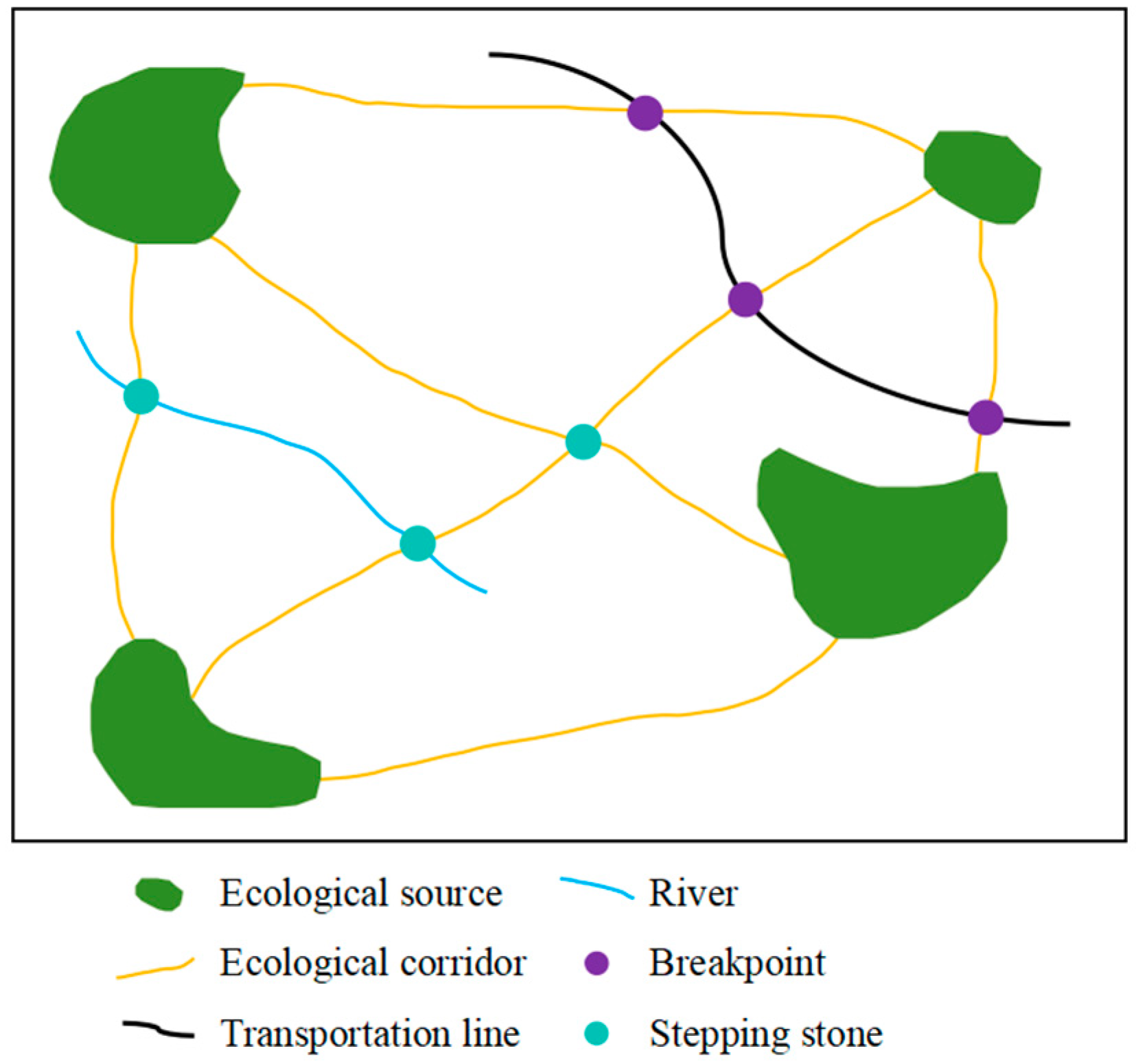
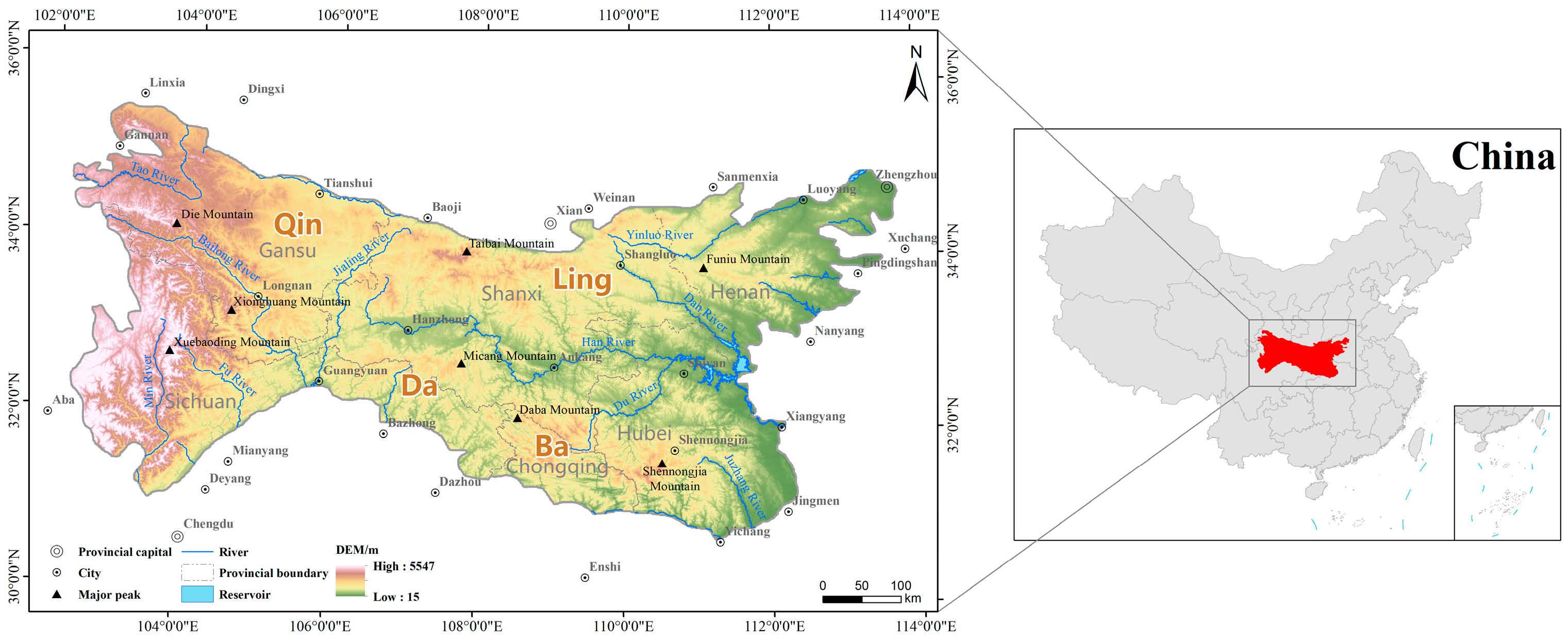
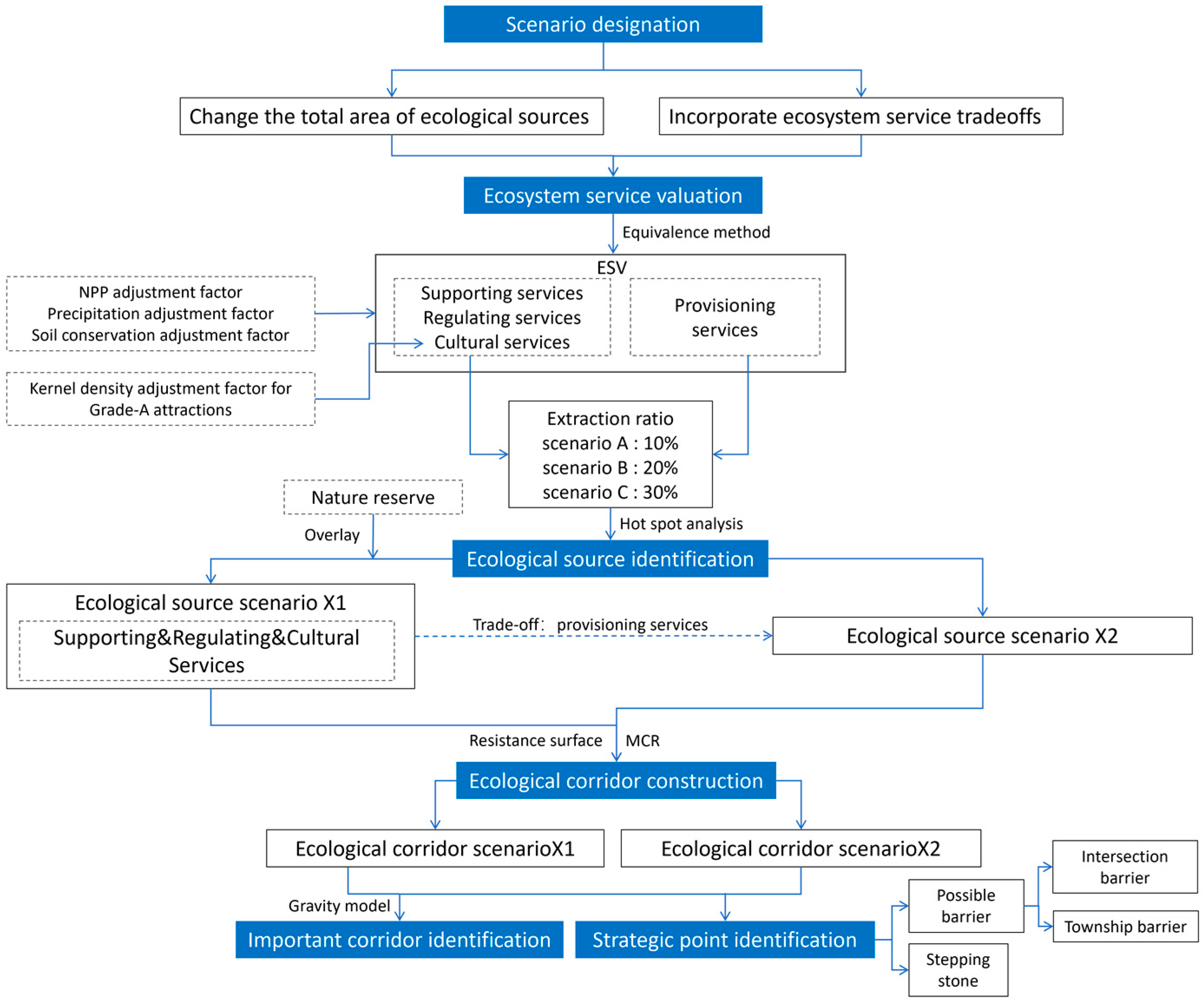
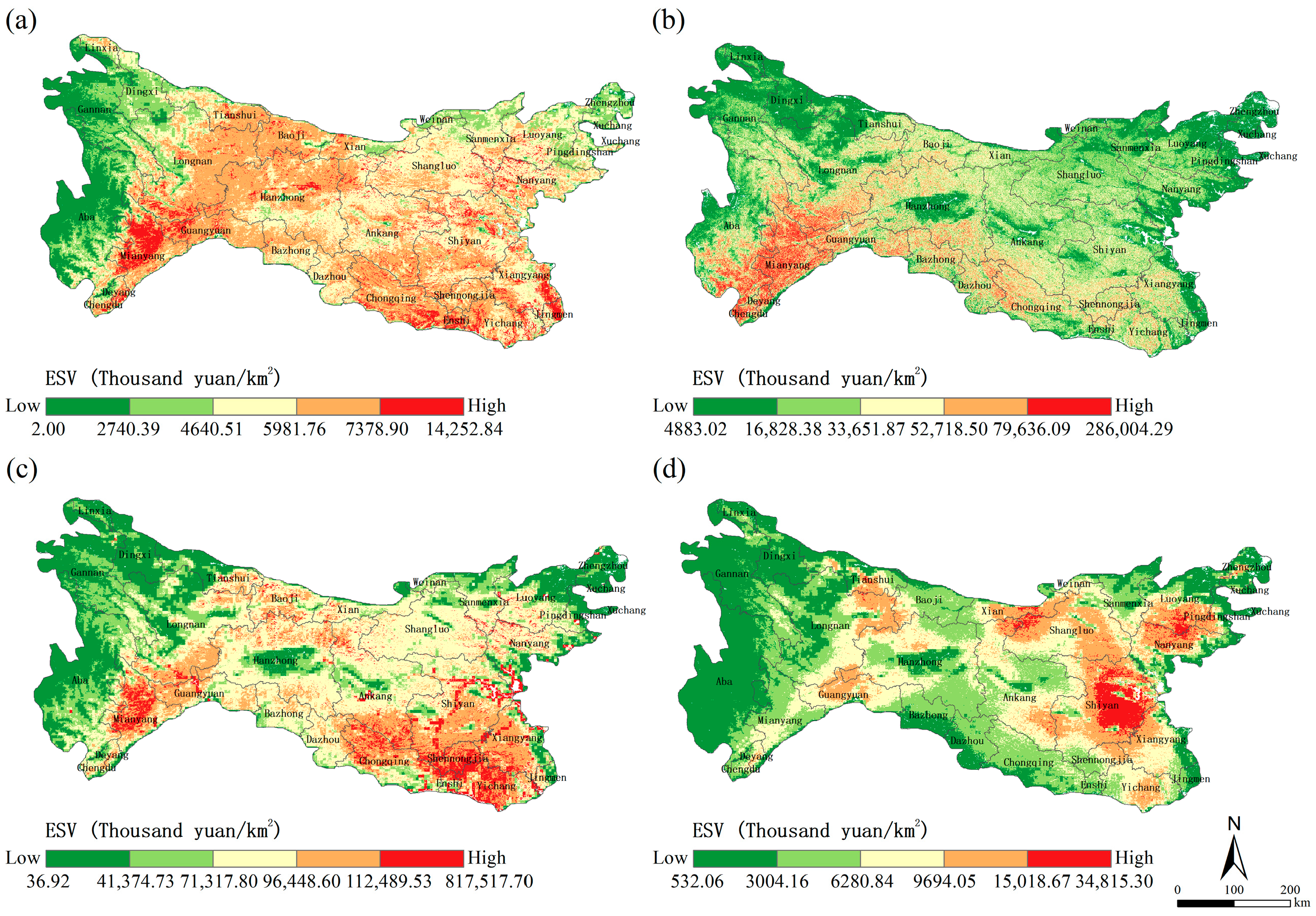
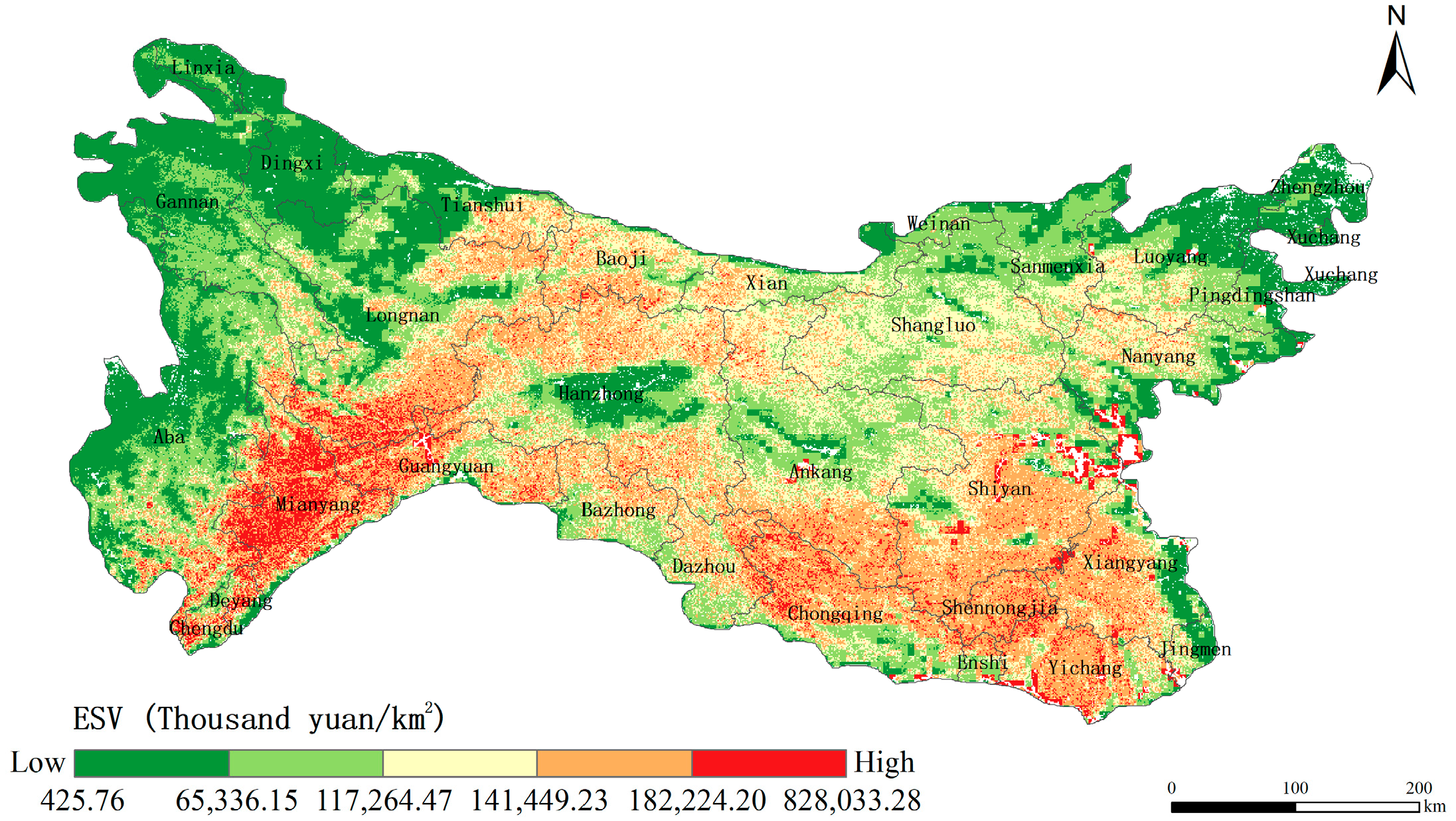
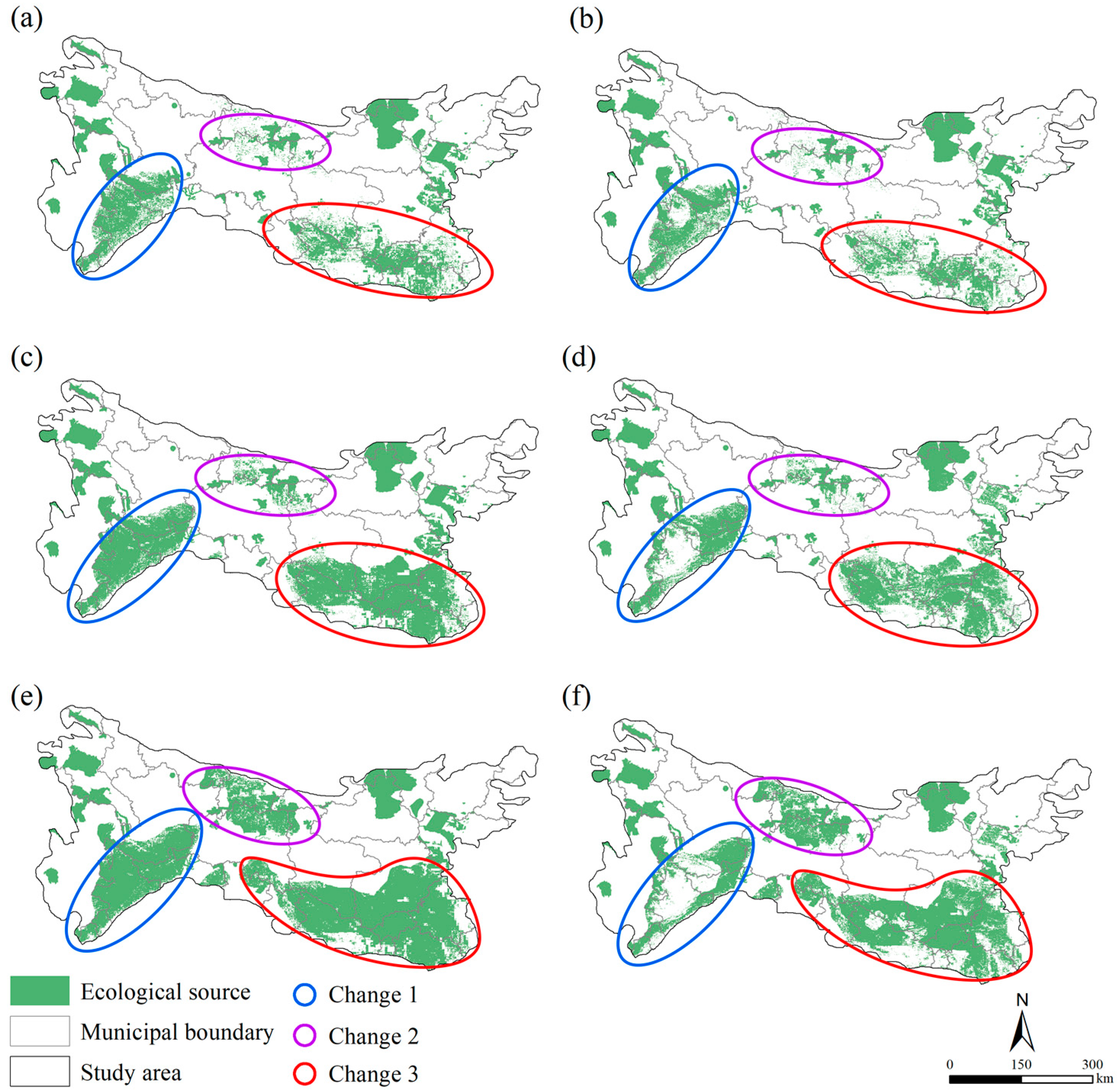


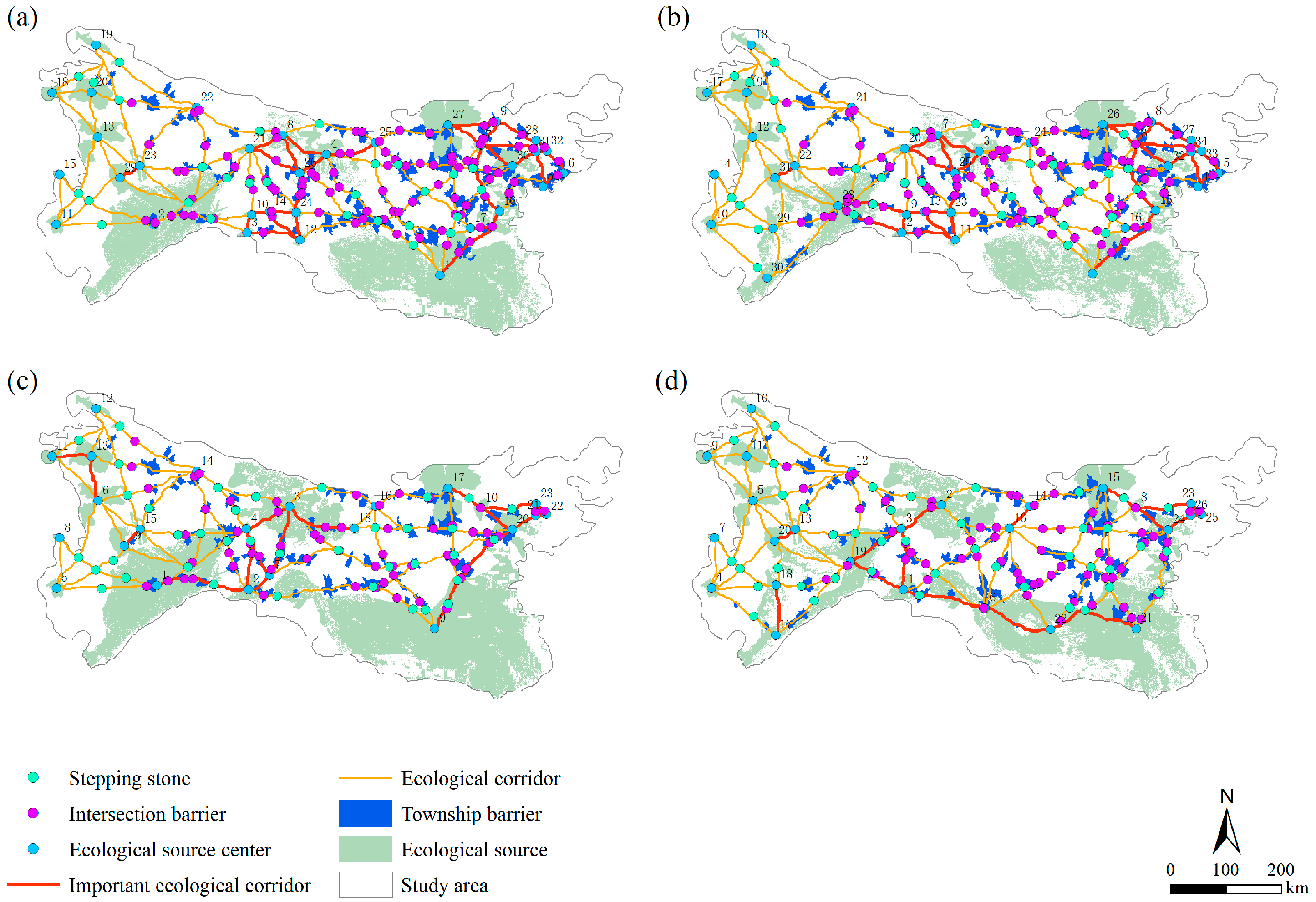
| Data | Resolution/Year | Source | Processing |
|---|---|---|---|
| Digital elevation model (DEM) | 30 m/2020 | NASA https://www.nasa.gov (6 October 2024) | Processed with ArcGIS10.8 to obtain elevation and slope. |
| Land use and land cover | 30 m/2020 | CAS Earth Data Sharing and Service Portal https://data.casearth.cn (6 October 2024) | Reclassified into 12 ecosystems. |
| Normalized difference vegetation index (NDVI) | 30 m/2020 | Resources and Environmental Science Data Center https://www.resdc.cn (6 October 2024) | |
| Net primary production (NPP) | 500 m/2020 | United States Geological Survey (USGS) https://www.usgs.gov (6 October 2024) | |
| Precipitation | 1000 m/2020 | National Earth System Science Data Centre http://www.geodata.cn (6 October 2024) | |
| Soil retention data | 300 m/2020 | https://www.scidb.cn/en [31] (6 October 2024) | |
| Built-up areas of Chinese cities | 10 m/2020 | https://www.scidb.cn/en [32] (6 October 2024) | |
| Rivers and roads | / | Open Street Map, National Geomatics of China https://www.openstreetmap.org (6 October 2024) https://www.webmap.cn (6 October 2024) | |
| Natural reserves (NRs) | / | Geographic remote sensing ecological network platform http://www.gisrs.cn/index.html (6 October 2024) | |
| Population | 1000 m/2019 | OakRidge National Laboratory https://landscan.ornl.gov (6 October 2024) | |
| A-level scenic spots | / | Official website of Culture and Tourism Bureau | Converted to points with geographic coordinates in ArcGIS |
| Scenario | Scenario | Scenario Note |
|---|---|---|
| A | A1 | Extract the top 10 percent of the study area regarding the integrated value of supporting, regulating, and cultural services. The extracted regions and natural reserves are set as ecological sources. |
| A2 | The top 10 percent of the area for provisioning service values is removed from the ecological sources in Scenario A1, and the remaining regions are set as ecological sources. | |
| B | B1 | Extract the top 20 percent of the study area regarding the integrated value of supporting, regulating, and cultural services. The extracted regions and natural reserves are set as ecological sources. |
| B2 | The top 20 percent of the area for provisioning service values is removed from the ecological sources in Scenario B1, and the remaining regions are set as ecological sources. | |
| C | C1 | Extract the top 30 percent of the study area regarding the integrated value of supporting, regulating, and cultural services. The extracted regions and natural reserves are set as ecological sources. |
| C2 | The top 30 percent of the area for provisioning service values is removed from the ecological sources in Scenario C1, and the remaining regions are set as ecological sources. |
| Ecosystems | Provisioning Services | Regulating Services | Supporting Services | Cultural Services | |||||||
|---|---|---|---|---|---|---|---|---|---|---|---|
| Category | Subcategory | Food Production | Raw Material Production | Gas Regulation | Climate Regulation | Decontaminate Environment | Hydrological Regulation | Soil Conservation | Maintaining Nutrient Cycling | Biodiversity Protection | Aesthetic Landscape |
| farmland | dry land | 1525.17 | 717.73 | 1202.19 | 645.95 | 179.43 | 484.46 | 1848.14 | 215.32 | 233.26 | 107.66 |
| paddy field | 2440.27 | 161.49 | 1991.69 | 1022.76 | 305.03 | 4880.53 | 17.94 | 340.92 | 376.81 | 161.49 | |
| forest | coniferous forest | 394.75 | 933.04 | 3050.33 | 9097.17 | 2673.53 | 5993.01 | 3696.28 | 287.09 | 3373.31 | 1471.34 |
| broadleaved forest | 520.35 | 1184.25 | 3893.66 | 11,663.04 | 3463.02 | 8505.04 | 4754.93 | 358.86 | 4324.29 | 1901.97 | |
| bush | 340.92 | 771.55 | 2529.98 | 7589.94 | 2296.72 | 6010.95 | 3086.22 | 233.26 | 2817.07 | 1238.08 | |
| grassland | prairie | 179.43 | 251.20 | 915.10 | 2404.38 | 789.50 | 1758.43 | 1112.47 | 89.72 | 1004.82 | 448.58 |
| shrubs | 681.84 | 1004.82 | 3534.80 | 9348.37 | 3086.22 | 6854.28 | 4306.35 | 322.98 | 3911.60 | 1722.54 | |
| wetland | wetland | 915.10 | 897.16 | 3409.19 | 6459.53 | 6459.53 | 43,476.21 | 4144.86 | 322.98 | 14,121.24 | 8487.10 |
| bare land | bare land | 0.00 | 0.00 | 35.89 | 0.00 | 179.43 | 53.83 | 35.89 | 0.00 | 35.89 | 17.94 |
| water area | waterbody | 1435.45 | 412.69 | 1381.62 | 4108.98 | 9958.44 | 183,450.57 | 1668.71 | 125.60 | 4575.50 | 3391.25 |
| glacier and snow | 0.00 | 0.00 | 322.98 | 968.93 | 287.09 | 12,793.45 | 0.00 | 0.00 | 17.94 | 161.49 | |
| construction area | construction area | 0.00 | 0.00 | 0.00 | 0.00 | 0.00 | 0.00 | 0.00 | 0.00 | 0.00 | 0.00 |
| Resistance Factor | Weight | Grading Standard | Resistance Value | Resistance Factor | Weight | Grading Standard | Resistance Value |
|---|---|---|---|---|---|---|---|
| Land Use Type | 0.4 | Forest, Wetland | 1 | Elevation (m) | 0.15 | <700 | 10 |
| Grassland, Water | 20 | 1000 | 30 | ||||
| Cropland | 50 | 1500 | 50 | ||||
| Desert | 70 | 2000 | 70 | ||||
| Construction Land | 90 | >2000 | 90 | ||||
| Distances from Main Roads (m) | 0.03 | 1000 | 90 | Slope (°) | 0.1 | 0°–8° | 10 |
| 3000 | 70 | 8°–15° | 30 | ||||
| 5000 | 50 | 15°–25° | 50 | ||||
| 10,000 | 30 | 25°–35° | 70 | ||||
| >10,000 | 10 | >35° | 90 | ||||
| Distances from Main Railways (m) | 0.03 | 1000 | 90 | Vegetation Cover (%) | 0.21 | 0–20 | 90 |
| 3000 | 70 | 20–40 | 70 | ||||
| 5000 | 50 | 40–60 | 50 | ||||
| 10,000 | 30 | 60–80 | 30 | ||||
| >10,000 | 10 | 80–100 | 10 | ||||
| Distances from Main Water Bodies (m) | 0.05 | 1000 | 10 | Distances from Main Urban Areas (m) | 0.02 | 1000 | 90 |
| 2000 | 30 | 3000 | 70 | ||||
| 5000 | 50 | 5000 | 50 | ||||
| 10,000 | 70 | 10,000 | 30 | ||||
| >10,000 | 90 | >10,000 | 10 |
| Sight | Number of Source Sites | Total Source Area (km2) | Total Area of the Study Area (%) | Forested Land in Total Source Area (%) | Grassland as a Percentage of Total Source Area (%) | Cultivated Land in Total Area of Source Land (%) |
|---|---|---|---|---|---|---|
| A1 | 26 | 67,884.64 | 21.76 | 82.65 | 8.04 | 8.02 |
| A2 | 27 | 62,743.81 | 20.11 | 82.21 | 8.66 | 7.77 |
| B1 | 32 | 91,354.42 | 29.28 | 84.88 | 6.15 | 7.83 |
| B2 | 34 | 75,942.13 | 24.34 | 84.01 | 7.27 | 7.46 |
| C1 | 23 | 114,748.14 | 36.78 | 86.40 | 5.08 | 7.54 |
| C2 | 26 | 92,956.31 | 29.79 | 85.83 | 6.10 | 7.00 |
| Scenario | Number of Corridors | Total Length of Corridor (km) | Average Length (km) | Corridor Density (km/km2) |
|---|---|---|---|---|
| B1 | 68 | 8812.95 | 129.60 | 2.82 |
| B2 | 74 | 9212.25 | 124.49 | 2.95 |
| C1 | 52 | 7361.55 | 141.57 | 2.36 |
| C2 | 60 | 8384.43 | 139.74 | 2.69 |
| Sight | Number of Ecological Corridors of Importance | Total Length (km) | Average Length (km) | Number of Intersection Barriers | Number of Township Barriers | Number of Stepping Stones |
|---|---|---|---|---|---|---|
| B1 | 30 | 2122.72 | 70.76 | 98 | 162 | 28 |
| B2 | 31 | 2200.76 | 70.99 | 94 | 149 | 31 |
| C1 | 18 | 1588.36 | 88.24 | 66 | 125 | 38 |
| C2 | 17 | 1461.59 | 85.98 | 71 | 137 | 42 |
Disclaimer/Publisher’s Note: The statements, opinions and data contained in all publications are solely those of the individual author(s) and contributor(s) and not of MDPI and/or the editor(s). MDPI and/or the editor(s) disclaim responsibility for any injury to people or property resulting from any ideas, methods, instructions or products referred to in the content. |
© 2024 by the authors. Licensee MDPI, Basel, Switzerland. This article is an open access article distributed under the terms and conditions of the Creative Commons Attribution (CC BY) license (https://creativecommons.org/licenses/by/4.0/).
Share and Cite
Zhang, P.; Song, M.; Lu, Q. Mapping Ecological Security Patterns Based on Ecosystem Service Valuation in the Qinling-Daba Mountain Area, China: A Multi-Scenario Study for Development and Conservation Tradeoffs. Land 2024, 13, 1629. https://doi.org/10.3390/land13101629
Zhang P, Song M, Lu Q. Mapping Ecological Security Patterns Based on Ecosystem Service Valuation in the Qinling-Daba Mountain Area, China: A Multi-Scenario Study for Development and Conservation Tradeoffs. Land. 2024; 13(10):1629. https://doi.org/10.3390/land13101629
Chicago/Turabian StyleZhang, Pingping, Mingjie Song, and Qiaoqi Lu. 2024. "Mapping Ecological Security Patterns Based on Ecosystem Service Valuation in the Qinling-Daba Mountain Area, China: A Multi-Scenario Study for Development and Conservation Tradeoffs" Land 13, no. 10: 1629. https://doi.org/10.3390/land13101629
APA StyleZhang, P., Song, M., & Lu, Q. (2024). Mapping Ecological Security Patterns Based on Ecosystem Service Valuation in the Qinling-Daba Mountain Area, China: A Multi-Scenario Study for Development and Conservation Tradeoffs. Land, 13(10), 1629. https://doi.org/10.3390/land13101629






